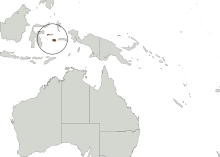Buru babirusa
| Buru babirusa | |
|---|---|
 |
|
| Scientific classification | |
| Kingdom: | Animalia |
| Phylum: | Chordata |
| Class: | Mammalia |
| Order: | Artiodactyla |
| Family: | Suidae |
| Genus: | Babyrousa |
| Species: | B. babyrussa |
| Binomial name | |
|
Babyrousa babyrussa (Linnaeus, 1758) |
|
 |
|
| Range (in brown) | |
The Buru babirusa (Babyrousa babyrussa), also known as the Moluccan babirusa, golden babirusa or hairy babirusa, is a wild pig-like animal native to the island of Buru and the two Sula Islands of Mangole and Taliabu, all belonging to Indonesia. Traditionally, this relatively small species included the other babirusas as subspecies, but it has been recommended treating them as separate species based on differences in their morphology. As also suggested by its alternative common names, the Buru Babirusa has relatively long thick, gold-brown body-hair – a feature not shared by the other extant babirusas.
In absence of detailed data on B. babyrussa, it is generally assumed that its habitat and ecology are similar to that of B. celebensis (north Sulawesi babirusa). Furthermore, as all babirusas were considered conspecific under the scientific name B. babyrussa until 2001, data collected before that is consistently listed under the name B. babyrussa, though the vast majority actually refers to B. celebensis (by far the best known species of babirusa). Babirusas tend to occupy tropical rainforests, river banks and various natural ponds rich in water plants. They are omnivorous and feed on various leaves, roots, fruits, invertebrates and small vertebrates. Their jaws and teeth are strong enough to crack any kind of nuts. Babirusas lack the rostral bone in their nose, which is a tool used by other wild pigs for digging. Therefore, they prefer feeding on roots in soft muddy or sandy soils. Cannibalism was reported among babirusas, feeding on the young of their own species or other mammals.North Sulawesi babirusas form groups with up to a dozen of individuals, especially when raising their young. Older males might live individually.
...
Wikipedia

